Video game development once took years - now, AI is helping teams shave off months. Some studios report up to 40% faster production cycles, all without expanding their workforce. From concept art to post-launch tuning, intelligent systems are quietly rewriting the rules.
The real question isn’t what AI can do - it’s how AI can optimize gaming development projects without breaking creative flow.
In this article, we will delve into:
- Speed up game creation with smarter AI-driven workflows
- See how top studios are using AI to gain a real edge
- Understand the risks before going all-in on AI in games
Build Better Games Faster: How AI Automation is Reshaping Modern Development
Game development has entered a new era where AI isn't just helpful - it's essential. Studios worldwide are discovering that AI can reduce development time by 40-60% while dramatically improving game quality. From asset creation to testing, AI is transforming every aspect of how games are built.
Asset Creation and Content Generation
AI is revolutionizing how developers create game assets, turning weeks of manual work into minutes of automated generation. This transformation is saving studios millions in development costs while enabling faster iteration and creative exploration.
- 3D Model Generation: Tools like Meshy create production-ready models in just 30 seconds from text descriptions or images, allowing developers to generate detailed characters, props, and environments instantly while reducing traditional modeling costs by 60-80%
- Automated Texture Creation: AI systems reduce manual texture work by 70% by analyzing existing art styles and generating hundreds of consistent, seamlessly-tiling textures that maintain visual coherence across entire game worlds
- Environment Design: Promethean AI transforms natural language into complete 3D scenes, allowing designers to describe environments like "abandoned space station with flickering lights" and receive fully populated levels with proper lighting, props, and spatial layout
- Character Animation: Cascadeur's physics-based system automatically applies realistic motion physics, enhances motion capture data, and creates believable character movement without requiring extensive manual frame-by-frame adjustment
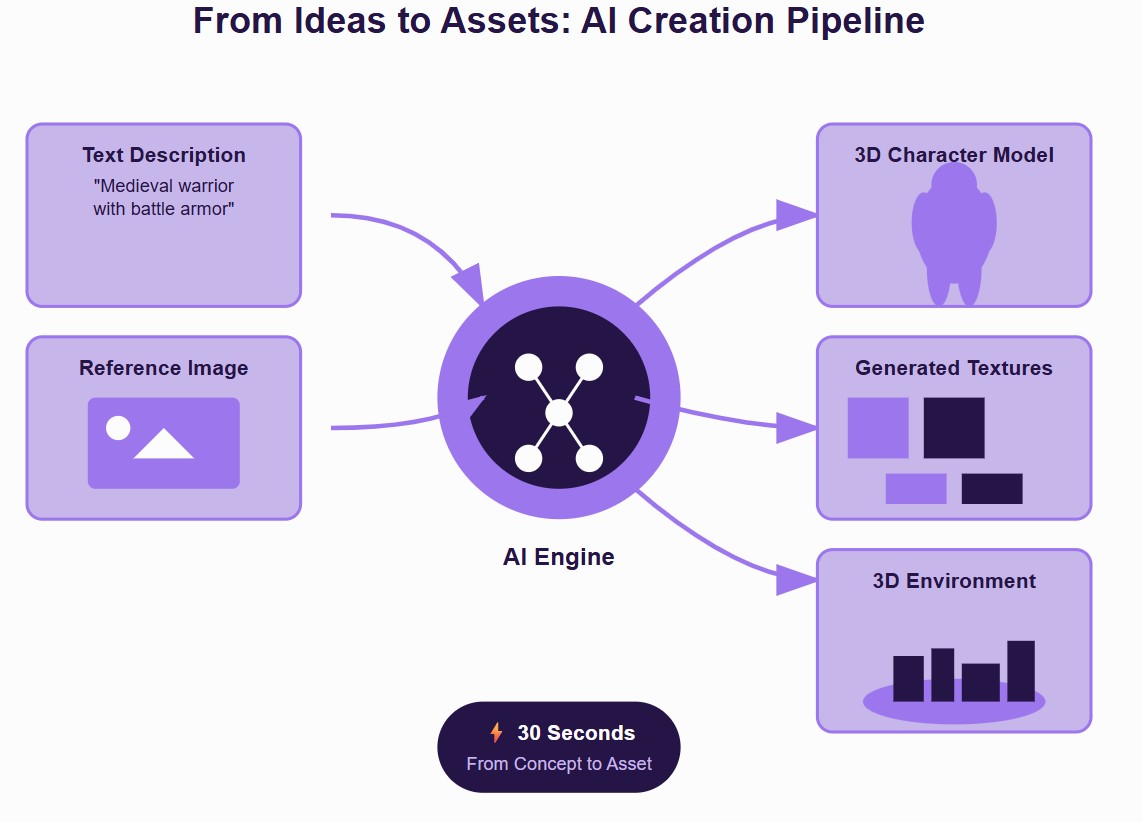
Automated Testing and Quality Assurance
AI testing systems work 24/7 to identify issues that human testers miss, reducing bug-related delays by up to 80% and ensuring higher-quality releases through comprehensive automated analysis.
- Advanced Bug Detection: AI excels at spotting pixel-level visual inconsistencies, performance drops, and logic errors that human testers typically miss, using computer vision algorithms to scan every frame for texture seams, lighting errors, and memory leaks before they cause crashes
- Performance Optimization: Real-time monitoring systems track frame rates, loading times, CPU/GPU utilization, and memory usage, functions that mirror how AI project management software for IT professionals manages performance bottlenecks in large-scale dev teams.
- Comprehensive Testing Coverage: AI can simulate hundreds of gameplay scenarios simultaneously, testing every possible game path, edge cases, save/load systems, and multiplayer balance while ensuring compatibility across thousands of hardware combinations and operating systems
- Quality Assurance Automation: Automated systems verify controller support, accessibility compliance, and performance scaling across console, PC, and mobile platforms, ensuring universal playability without extensive manual testing phases.
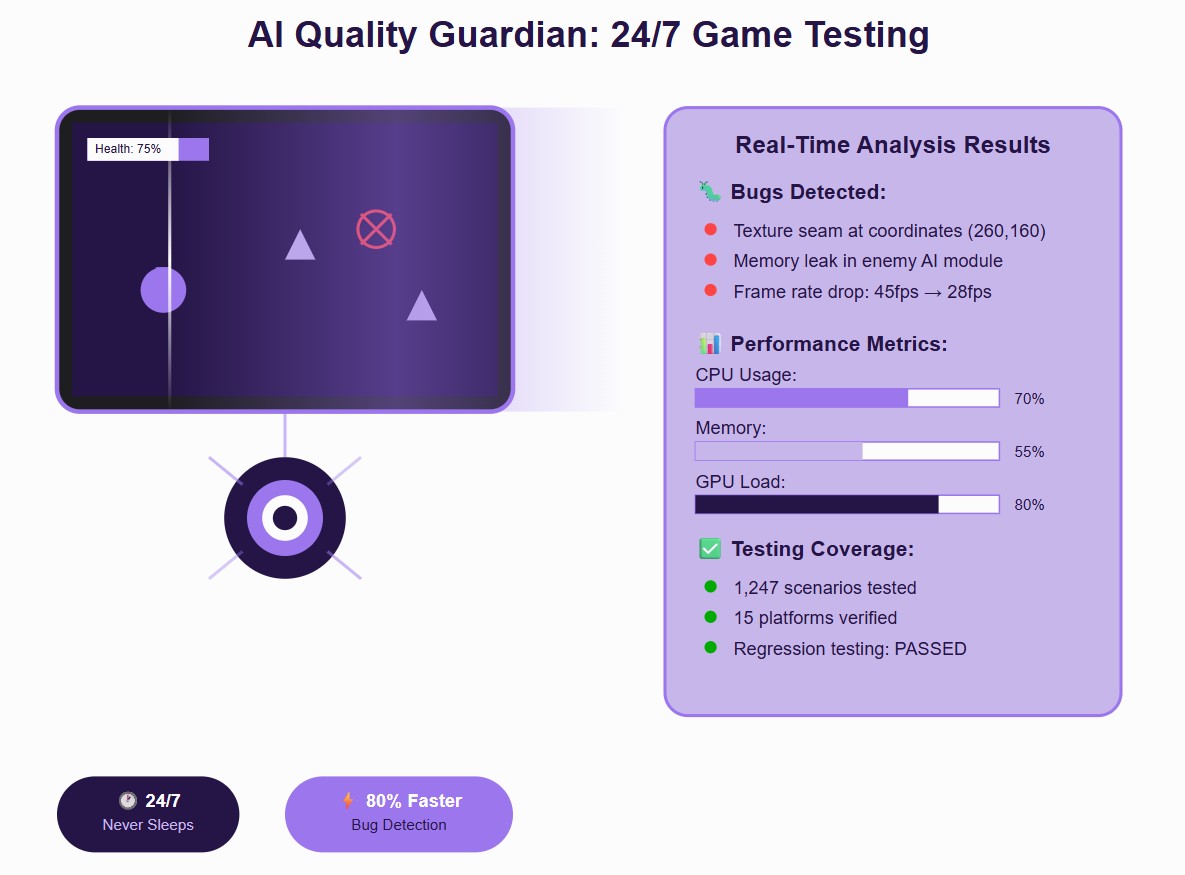
Workflow Streamlining and Project Management
70% of studios now use AI in pre-production, recognizing its power to optimize team productivity and project timelines while reducing costly development bottlenecks through intelligent automation and predictive analytics.
- Pre-production Acceleration: AI validates concepts through rapid prototyping, analyzes market trends and player preferences, assesses the technical feasibility of proposed features, and provides accurate resource requirement predictions for realistic project planning
- Code Development Support: AI-assisted programming reduces development time by automating boilerplate code generation, predicting bugs before commits, suggesting performance optimizations, and automatically generating comprehensive documentation from code comments
- Project Coordination: Predictive analytics optimize project management through timeline prediction based on historical data, resource allocation matching skills to tasks, milestone tracking with automatic progress reporting, and early warning systems for risk mitigation
- Team Optimization: AI determines optimal team assignments by analyzing individual capabilities, balancing workloads to prevent burnout, suggesting cross-training opportunities, and tracking performance analytics to identify successful practices and improvement areas
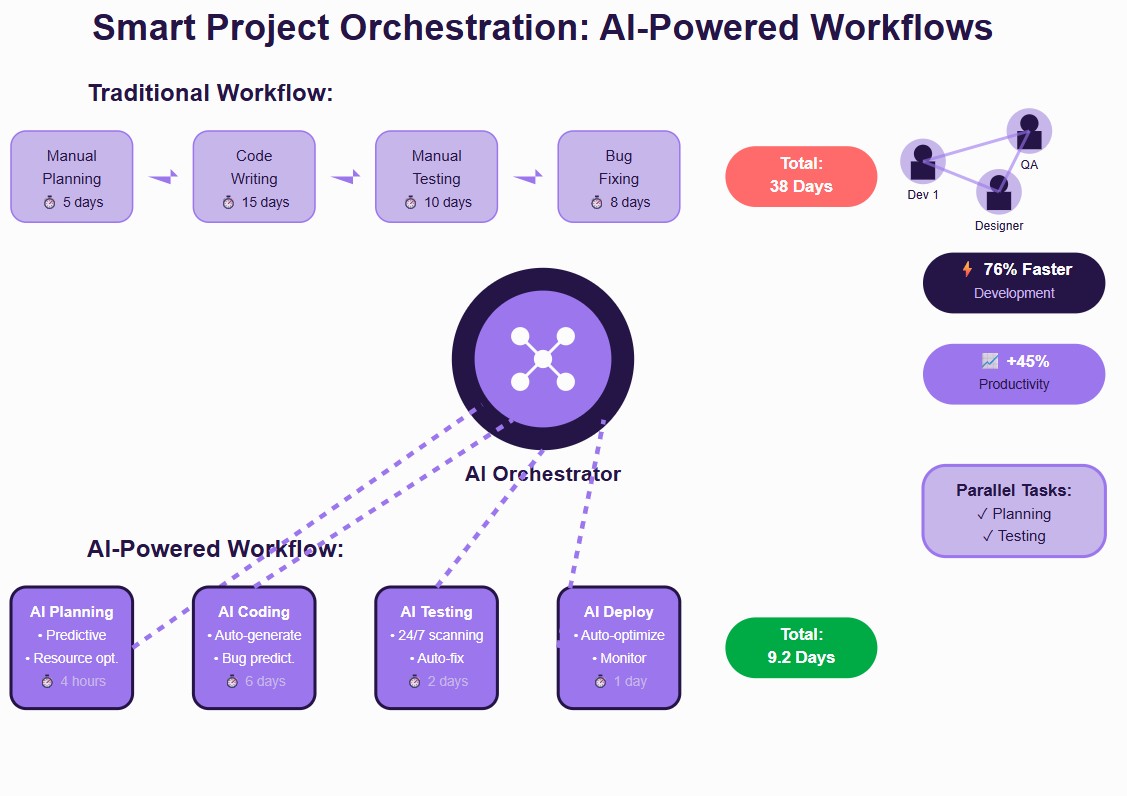
Player Experience Enhancement
AI creates personalized gaming experiences that adapt to individual players, increasing engagement by 45% and extending game longevity through dynamic content generation and intelligent behavior systems.
- Dynamic Difficulty Adjustment: Real-time adaptation systems monitor player performance, adjust enemy strength and puzzle complexity in real-time, analyze emotional states to detect frustration or boredom, and provide accessibility support without compromising game integrity
- Procedural Content Generation: AI creates infinite content variety through endless level variations, dynamically generated quests and objectives, balanced loot randomization systems, and environmental changes that affect gameplay mechanics and narrative branching
- Intelligent NPC Behavior: Advanced behavior systems enable natural dialogue through conversational AI, authentic emotional responses to player actions, memory systems that remember past interactions, and social dynamics where NPCs interact realistically with each other
- Personalized Gaming: Tailored experiences analyze individual play styles to identify preferences for combat, exploration, or puzzles, recommend content based on behavior patterns, customize UI elements automatically, and create personalized achievement systems that maintain long-term player motivation
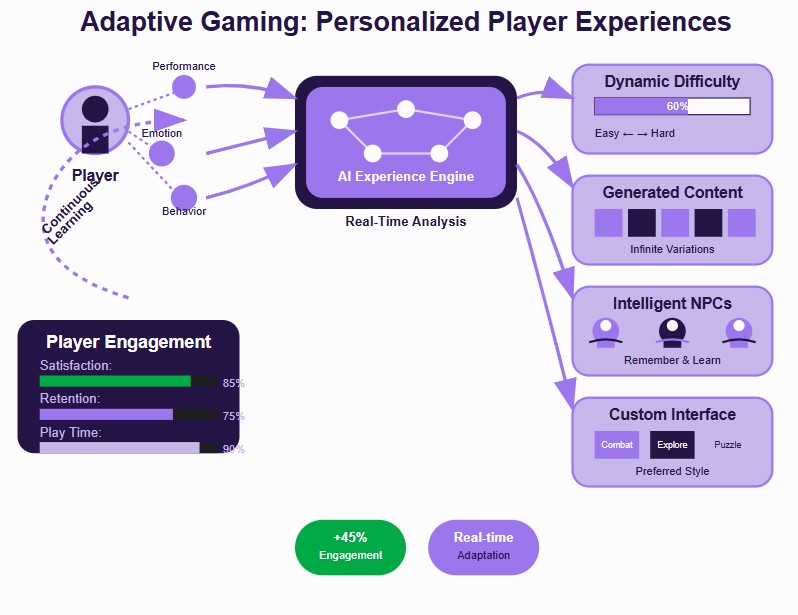
With AI handling repetitive tasks, developers can focus on innovation, storytelling, and creating memorable player experiences that define the next generation of gaming.
Success Stories from the Gaming Frontlines: How Top Studios Are Winning with AI
The gaming industry's AI transformation isn't theoretical; it's happening right now in studios worldwide. From AAA powerhouses to innovative indies, developers are achieving remarkable results by strategically implementing AI technologies.
These verified case studies reveal the concrete benefits and measurable outcomes from real-world AI deployments.
Ubisoft's Ghostwriter: Revolutionizing NPC Dialogue Generation
The Challenge: Creating thousands of "bark" lines (short NPC phrases) for massive open-world games was consuming enormous amounts of writer time, preventing focus on core narrative elements.
AI Solution: Ubisoft developed Ghostwriter, an in-house tool that generates first drafts of NPC barks. The system provides two variation choices for each generated phrase, allowing scriptwriters to compare and select preferences while the AI learns from their decisions.
Implementation:
- Natural Language Input: Writers input character details and interaction types, receiving multiple dialogue variations
- Continuous Learning: After thousands of writer selections, the tool becomes increasingly effective and accurate
- Targeted Use: Specifically handles crowd chatter, background lines, UI text, and dialogue paraphrasing
Verified Results: Writers found the tool particularly effective for paraphrasing tasks, eliminating creative struggle when generating 10 versions of lines like "I'm reloading!" Data analysis revealed that "confident" or "excited" barks were frequently accepted, while "irritated" variations were rejected more often.
EA Sports: AI-Powered Player Behavior Modeling
The Challenge: Creating authentic player behaviors and realistic sports simulations that mirror real-world athlete performance across multiple sports franchises.
AI Solution: Madden NFL 26 uses AI-driven machine learning trained on nearly a decade of real NFL data, introducing QB DNA and Coach DNA for authentic behaviors. EA SPORTS FC 24 employs HyperMotionV technology, capturing data from over 180 top-tier matches, including UEFA Champions League and Premier League games.
Technical Implementation:
- Real-World Data Integration: Virtual players make decisions using machine learning algorithms trained on actual athlete performance
- Advanced Motion Capture: System includes over 11,000 true-to-football animations, nearly double previous versions
- Elite Team Analysis: Teams like Real Madrid, PSG, and Manchester City provide movement data for in-game replication
Verified Results: The technology successfully captures the rhythm and fluidity of real-world sports, with EA claiming to deliver "the realest Madden to date" through authentic quarterback behaviors and adaptive coaching strategies.
Ninja Theory: Breakthrough Facial Animation Technology
The Challenge: Achieving photorealistic facial animations for emotionally intense storytelling while maintaining production efficiency and character authenticity.
AI Solution: Ninja Theory partnered with Epic Games to utilize Unreal Engine's Metahuman tool for Hellblade 2, creating photorealistic digital humans with unprecedented realism and customization. Their real-time motion capture system uses Cubic Motion technology, tracking 30 to 40 points inside the lips alone.
Innovation Breakthrough:
- Markerless Capture: Gathers facial data from video footage without requiring facial markers on actors
- Real-Time Processing: Creates 3D point clouds with roughly 200 virtual markers instantly replicated by digital character rigs
- Ultimate Flexibility: In-house setup allows shooting in the morning and implementing in the game by afternoon
Verified Results: Ninja Theory's commercial director confirmed data quality was "as good as, if not better than, previous projects" while achieving significant cost savings. Having actress Melina Juergens available in-house five days a week provided unprecedented creative flexibility and rapid iteration.
Navigate the Shadows: Critical Challenges and Ethical Dilemmas in AI Gaming
As studios race to adopt AI for faster production and deeper personalization, they must also confront its creative, legal, and ethical trade-offs. From job displacement to data bias, here's what every game developer and publisher must keep in mind before fully embracing AI.
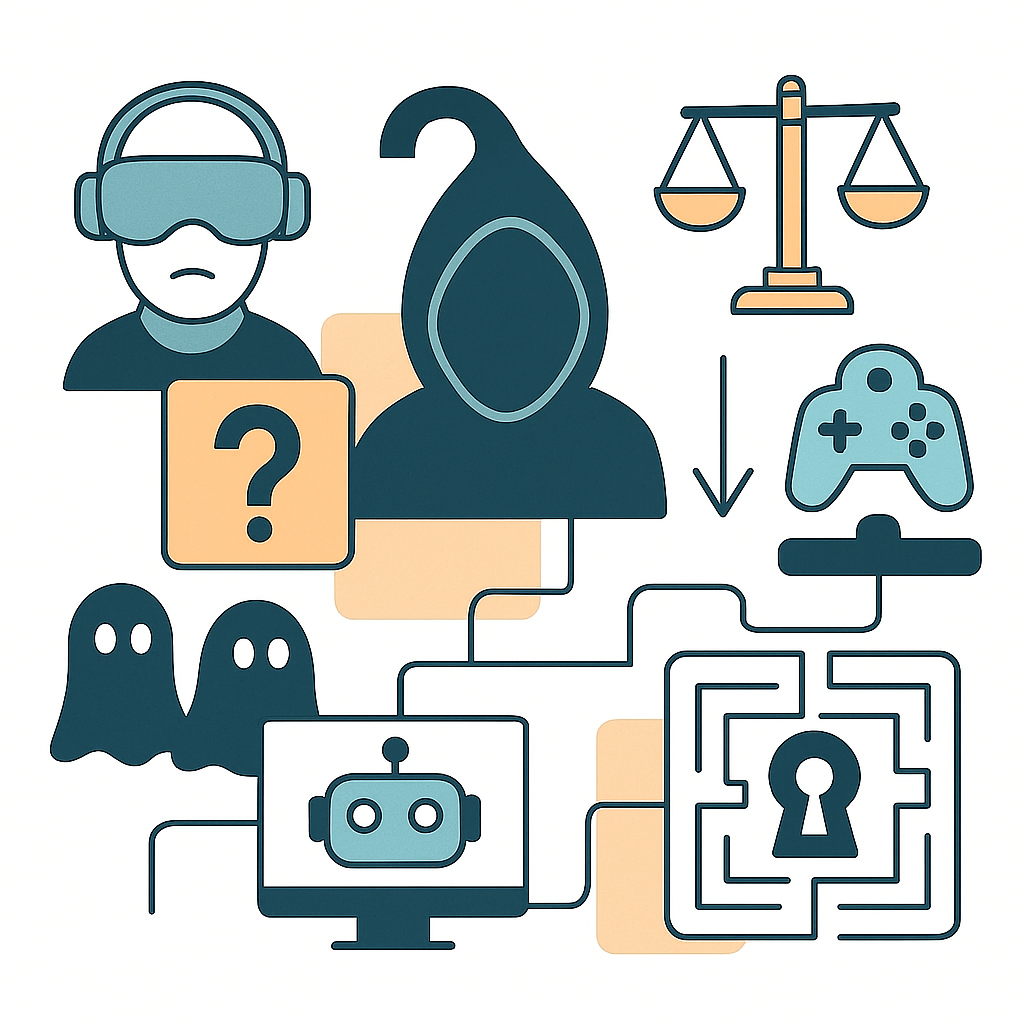
The Creative Risk: Could AI Replace Human Artists and Writers?
One of the biggest concerns in the gaming community is that AI could devalue or displace human creativity. Tools that auto-generate textures, models, animations, and dialogue may increase efficiency, but they also risk marginalizing roles traditionally held by artists, animators, and narrative designers.
- For instance, Ubisoft’s Ghostwriter can produce variations of NPC dialogue at scale. But where do we draw the line between assistance and replacement?
- Studios must tread carefully, ensuring that AI complements rather than replaces the human spark that makes games emotionally resonant and culturally relevant.
Bottom line: AI is a tool, not a storyteller. Without human oversight, it can’t produce truly original, meaningful experiences.
Copyright Confusion: Who Owns AI-Generated Game Assets?
As AI tools generate concept art, character designs, or environmental textures, copyright ambiguity becomes a legal minefield.
- Many AI models are trained on public datasets or scraped web content, often without the original creators’ consent.
- This raises uncomfortable questions: If your AI tool creates a stunning in-game creature that unintentionally mimics an artist’s design, can you be sued for infringement?
- Even more, current copyright laws in most jurisdictions don’t recognize AI as a legal creator, making ownership claims murky for developers and publishers.
Important consideration: Always verify the licensing model of your AI tools and consider limiting commercial use of outputs without clear legal standing.
Hidden Biases: How Flawed Training Data Can Break Immersion or Fairness
AI learns from the data it's fed, but that data isn’t always neutral. If an AI is trained on biased or unbalanced datasets, it may produce NPCs or gameplay mechanics that reflect stereotypes, reinforce harmful tropes, or skew game balance unfairly.
- Imagine an AI-generated NPC system that associates aggression more often with certain character features due to flawed training data.
- Or a difficulty system that consistently favors one playstyle over others, reducing accessibility for new or diverse players.
Solution: Developers must conduct bias audits on AI outputs, build in human checkpoints, and create diverse datasets that reflect broad audiences and playstyles.
Emotional Manipulation: Is AI Monetizing Human Psychology Unethically?
AI’s ability to track and model player behavior isn’t just a gameplay feature - it can also be used for monetization strategies that target emotional vulnerabilities.
- AI can detect frustration levels, spending habits, and player drop-off risk, and then serve hyper-personalized offers or reward-baiting mechanics.
- In extreme cases, this may evolve into predatory monetization, especially in younger or vulnerable audiences.
Examples include:
- Offering loot boxes or limited-time offers precisely when a player is most emotionally vulnerable
- Adjusting win/loss ratios to encourage spending
- Nudging players toward “pay-to-win” mechanics through algorithmic frustration
Ethical red flag: While personalization is valuable, manipulating psychology for profit crosses the line. Transparency and safeguards must be built into any AI-driven monetization system.
Bridge Concept to Completion Faster With AI Power
From generating art in seconds to running thousands of test cases overnight, AI is reshaping every stage of game development. It enables faster turnarounds, smarter workflows, and personalized player experiences - all without overextending your team.
By integrating AI where it matters most, studios can bridge creative vision and technical execution with speed and precision. The future of game dev is already in motion - optimize it.


.png)
_light%201.png)





